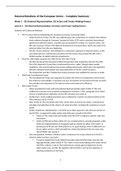Summary
External Relations of the European Union - Complete Summary
- Course
- Institution
This 17-page document provides a complete summary of the course External Relations of the European Union in the Master European Law School at Maastricht University, taught by Professor Andrea Ott. It contains the summaries of all the lectures and all the tutorials, including the case law and the re...
[Show more]












